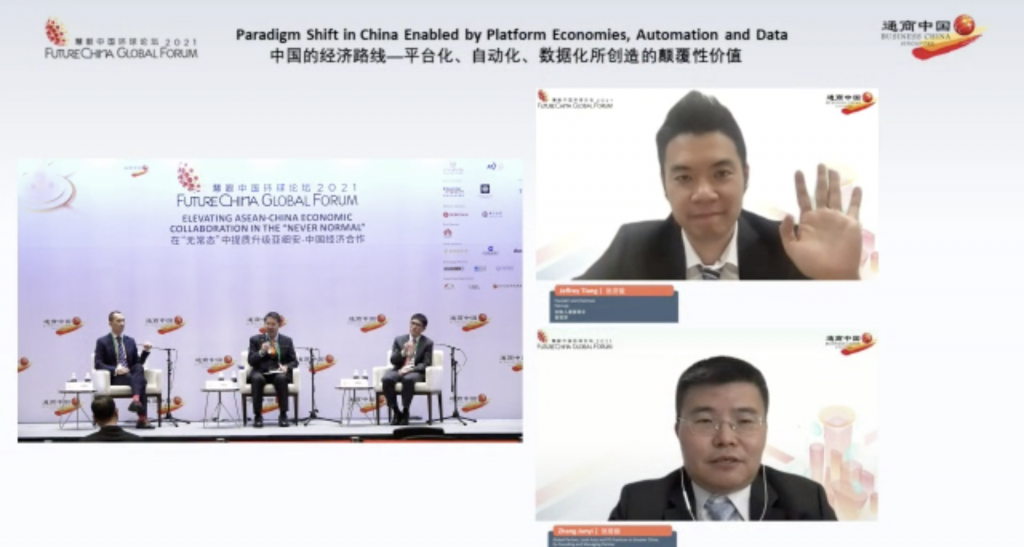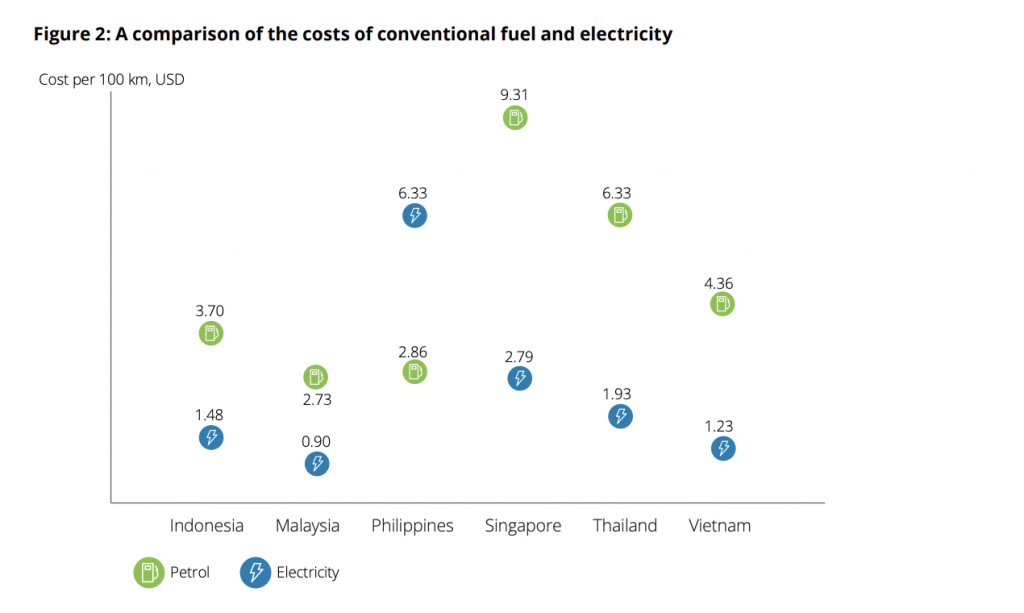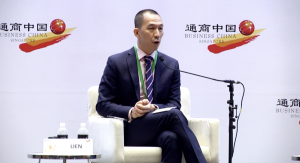Highlights
- In the past few years, China has made it a point to become self-reliant with its tech industries with government initiatives with the software and hardware the country’s tech poster boys are producing.
- Because of these self-reliance initiatives, there’s a new wave of “deep/high tech osmosis” from China to ASEAN is happening on two levels: tech companies and the government.
- Understanding regionalization and localization goes both ways. Even when it comes to learning from and expanding into China, regionalization must also be taken into account.
- Big tech regulation is not new, but the incentives for Southeast Asia are still pointed towards tech nationalization.
On 12 July 2021, Day 1 of the FutureChina Global Forum 2021, Yinglan moderated a panel on the “Paradigm Shift in China enabled by Platform Economies, Automation, and Data”. On the panel were Foo Fang Yong, CEO of Huawei International, Jeffrey Tiong, Founder and Chairman of Patsnap, Lien Choong Luen, General Manager of Gojek Singapore, and Zhang Junyi, Global Partner, Lead Auto and PE Practices in Greater China, at Oliver Wyman. This article is a recap of and commentary on this panel discussion within the context of the Forum’s main theme: “Elevating ASEAN-China Economic Collaboration in the “Never Normal””.

Panel moderated by Yinglan (second from left) at FCGF 2021. Guests from L-R, T-B: Gojek Singapore GM, Choong Huawei CEO Foo Fang Yong, Patsnap Founder and Chairman Jeffrey Tiong, and Oliver Wyman’s Zhang Junyi
In the past few years, China has made it a point to become self-reliant with its tech industries with government initiatives like Internet+, China Standards 2035, and Made in China 2025 (a ten year plan to upgrade ten high-tech industries including EVs, AVs, and advanced robotics). The goal with these initiatives is to lead the race in levelling up the country’s industries with cutting-edge technologies like AI, cloud computing, IoT, and big data — yes, I’ve used about seven tech buzzwords.
But for China, this is not just a gimmick or a trend. It is also a matter of survival and growth, especially in a geopolitical landscape where there are tensions on all its fronts and a post-pandemic world with new consumer behavior and demands for industry. We’re seeing this tech self-reliance not just with government initiatives, but also with the software and hardware the country’s tech poster boys are producing, like the HarmonyOS of Huawei.
Passing on the Torch in Deep Tech
So what does this mean for Southeast Asia?
Amidst geopolitical tensions and the onslaught of the pandemic, the region has established itself as lucrative green pastures for tech industries, startups, and private capital. China, along with most of the developed world, has been magnetized to find new opportunities in ASEAN countries, especially Singapore and Indonesia.
These self-reliance efforts in high tech from China means that with this pull of ASEAN on the rest of the world, we can also expect an osmosis in terms of data and technology best practices into the region from China. Granted, China has long been in this state of trade (not just economic trade) between the region as far back as history can tell. More recently, in this age of the internet economy, we’ve seen the export of business models (inspired by ones in the US) from China to Southeast Asia (Gojek vs Eleme and Meituan is an example). There’s also the offshoring of technology and industry capabilities to places like Vietnam for the cost arbitrage.
But this next wave of osmosis we are talking about is focused on the cutting-edge technologies we mentioned above and the corresponding best practices for application and regulation around it. There’s also the reality to consider in this next wave that innovation is making its way much faster to Southeast Asia than before. Singapore and Malaysia for example are already actively developing infrastructure to support electric vehicles. So the lag or gap between China and Southeast Asia (especially Singapore) may not be as wide as before.
This osmosis is happening on two levels: tech companies and the government. Tech companies like Huawei that are leading China’s digitalization have built the expertise in infrastructure and network of suppliers to bring not just learnings but tap into networks into ASEAN. As Huawei International’s CEO Fang Yong Foo says, “Huawei is actually number one among the top 100 to drive China’s digitalization, [and] our presence in ASEAN is huge. Our presence here in Southeast Asia actually allows us to leverage what we have learned in China and bring it into ASEAN.”
Apart from the formulas and networks of Chinese tech companies that already have a presence in Southeast Asia serving as a filter for this osmosis, there’s also the best practices to be learned from the government when it comes to incentivizing the private sector to focus on R&D and evaluate which technologies to focus on for mass adoption. In our podcast with Eezee, CTO Jasper Yap and CCO Shawn Seet talked about how the Singapore government initiative they are participating in to digitize government procurement sets a precedent for other businesses to also follow suit and have more confidence in digitalization.
This role of government could also go beyond single market impact within Southeast Asia. Apart from incentivizing business to embrace digital technologies, individual governments could germinate an ecosystem to provide integrated support across Southeast Asia. As Huawei’s Fang Yong Foo puts it, “Singapore can be the Shenzhen of Southeast Asia”, being the leader in setting deep technology standards for the region. With this ecosystem, the goal is to ensure the automation paradigm walks across different industries and markets, sort of an “Operating System” for a smarter city (which we wrote about back in 2019 with igloohome CEO Anthony Chow) that brings down the cost of pursuing deep technologies.
As Huawei’s Fang Yong Foo puts it, “Singapore can be the Shenzhen of Southeast Asia”, being the leader in setting deep technology standards for the region.
Understanding regionalization and localization goes both ways
That said, as we’ve emphasized time and time again, bringing learnings and resources into Southeast Asia is not so simple. Within countries like Indonesia, regions and provinces can vary greatly from each other in terms of consumer behavior and business practices.
Interestingly enough, Chinese tech CEOs also advise the same advice when it comes to getting learnings from China. Despite being largely monolithic, different regions have had different approaches to shaping the competitive landscape, sliding up and down the scale between organic and market-driven versus more government-controlled. This mindset is also important for tech founders and CEOs from Southeast Asia looking to expand their customer base or operations in China. Patsnap CEO Jeffrey Tiong maintains, “If you want to do business in China, you really have to be in China.”
For example, in the case of electric vehicles and autonomous vehicles, the propensity for countries in Southeast Asia to widely adopt this technology varies greatly, depending on the government policies in place, the opportunity cost for consumers to make the switch, and the costs to maintain this technology. And when it comes to taking best practices on the technology from China, it’s also important to take note of the regionalization within the country as well. Understanding regionalization and localization goes both ways.

From Deloitte’s 2021 review of Southeast Asia’s electric vehicle industry: https://www2.deloitte.com/content/dam/Deloitte/sg/Documents/strategy/sea-strategy-operations-full-speed-ahead-report.pdf
It’s important to note that while EVs and AVs seem to be simultaneously gaining attention, they solve radically different problems. As Gojek Singapore GM Choong Luen Lien puts it, “EVs address environmental problems, while AVs really solve the future of work.” Oliver Wyman Global Partner for Lead Auto and PE Practices Zhang Junyi adds that despite solving different problems, both industries show that the car’s role in society will undergo its own paradigm shift. “We are in the age of [revolutionizing] the car, it is not just for transportation, it [can also be] a second home.” It’s not just about having cars that use cleaner energy, but the raw materials themselves have to come from cleaner sources.
“We are in the age of [revolutionizing] the car, it is not just for transportation, it [can also be] a second home.” It’s not just about having cars that use cleaner energy, but the raw materials themselves have to come from cleaner sources.
Big Tech Regulation vs Tech Nationalization?
Apart from driving deep tech self-reliance, there’s also the question around increasing regulation of big tech and platform companies in China (which is also incidentally happening in the US) This is not new. Choong Luen Lien cites the regulation of the printing press in England by the Crown because they could regulate every single book. It is in a way inevitable for governments to intervene to varying degrees when it comes to platform economies (industries where platform companies emerge to tackle value chain inefficiencies). “China is not unique, any large country also has the same concerns around monopolies and holding companies accountable.”
That said, as we heard in our podcast with Paul Schulte, “I think right now in Southeast Asia, I think that we are looking at welcoming national champions right now. We are in a national champion formation stage, which tends to be very healthy and very lucrative. When these national champions become lazy monopolies, that’s when that’s a problem.”
Paulo Joquiño is a writer and content producer for tech companies, and co-author of the book Navigating ASEANnovation. He is currently Editor of Insignia Business Review, the official publication of Insignia Ventures Partners, and senior content strategist for the venture capital firm, where he started right after graduation. As a university student, he took up multiple work opportunities in content and marketing for startups in Asia. These included interning as an associate at G3 Partners, a Seoul-based marketing agency for tech startups, running tech community engagements at coworking space and business community, ASPACE Philippines, and interning at workspace marketplace FlySpaces. He graduated with a BS Management Engineering at Ateneo de Manila University in 2019.

